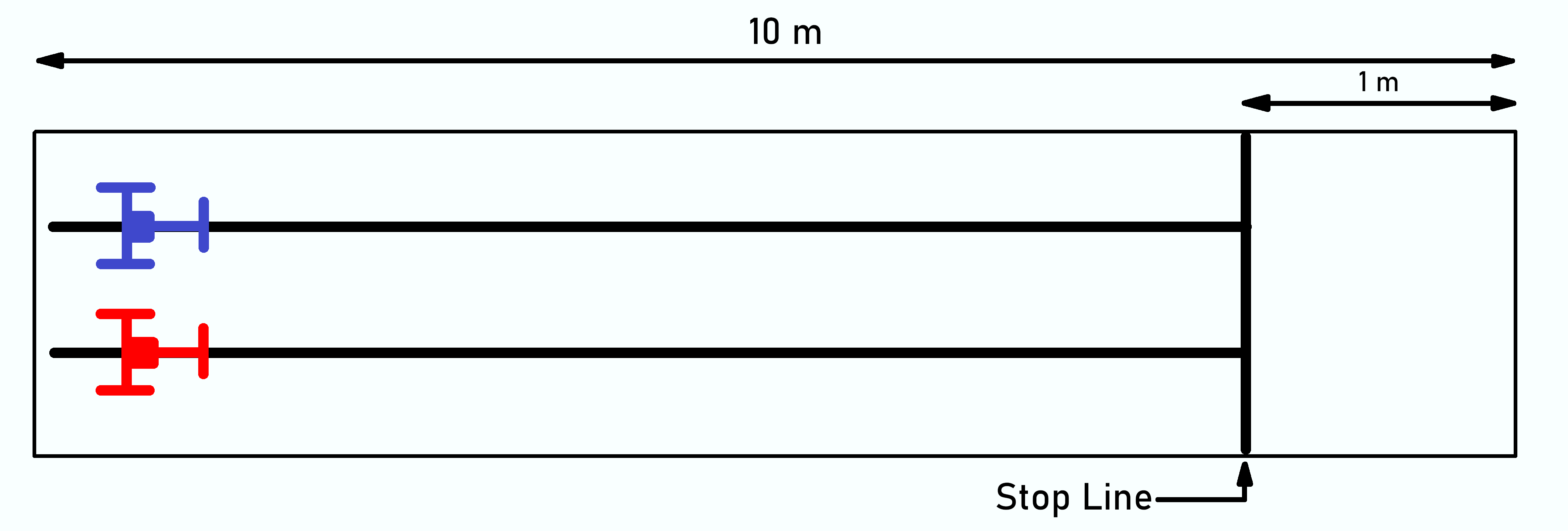There is no age limit.
Line follower Drag Race is an autonomous robot which follows either a black line on a white surface or a white line on a black surface. The line is simple, straight,, it does not have interruptions, sharp corners or bifurcations. The robot has to stop automatically once it crosses the finish line in a given stopping space.
1. Robot specifications
1.1. Autonomy
The robot must be fully autonomous, with one exception: one verified start stop module that will be controlled by the referee. The robot must be completely autonomous after passing the Start Line; if it is not, it will be disqualified. The robots must stop automatically in a given space after passing the finish line or else the robot will lose the round in favor to the opponent.
1.2. Size and Weight Limits
The maximum size of a robot is 30 cm wide by 60 cm long, the maximum weight is 3 kg. Dimensional and weight limits for robots shall be strictly enforced. Robots must have passed inspection prior to competing.
2. The Track
We consider Line Follower Drag Race the most fastest level of the Line Follower Style robot competitions aimed for participants who want to show the raw power their robot can unleash on a straight line.
2.1. Robots will compete in pairs on identical parallel tracks. As seen in figure 1.

Figure 1. Drag Race Track.
2.2. The robot with the fastest time will receive 1 point for each victory, all robots will compete with one another.
2.3. Track characteristics:
A. The race surface for the contest is a 10x1m area white colored.
B. There must NOT be crossovers (e.g. places where the line crosses itself)
C. The line shall be black, 15 mm wide.
D. The line will be straight without interruptions or curves
E. The stop line will be marked by an intersecting perpendicular line to the main line
F. The Stopping distance is 1 m long.
G. The closest approach of the line course to the edges of the arena shall be no less than 15 cm, measured from the center of the line.
H. There must NOT be curves.
3. Technical inspection
Before the competition, the robot must pass the technical inspection.
3.1. The maximum dimensions of the robot are 30 cm wide by 60 cm long and the maximum weight is 3kg.
3.2. The robot will have to be capable of making an entire lap of the track. For technical inspection the robot must complete one lap of the track.
3.3. The wheels of the robot and other parts that are in contact with the track must NOT be able to pick up and hold a standard paper A4 (80g/cm2) more than 2 seconds.
3.4. The robot must be completely autonomous after passing the Start Line; if not, it will be disqualified.
3.5. The Robot will be Checked for operation of the IR sensor to start and stop the robot.
4. Time
4.1. Time measured on the track
Time for each robot is measured from the moment of passing the start line until passing the finish line. Time for each robot is measured from the moment of passing the start line until passing the finish line.
It is considered that the robot finishes when the farthest point of it passes the line. It is considered that the robot finishes when the farthest point of it passes the line. The time is measured using an electronic gate (or a judge with a stopwatch in some cases).
During the competition each team will be called by the referee according to registration order.
4.2. Time Limit
Each robot has maximum 1 minute to finish the track. The robots will compete in a tournament style ranking, the fastest robot out of 3 rounds wins the match and receives one point. The time for the whole Drag Race contest is given according to the number of the participant. The category lasts around 1:30 hours (depending on the number of participants) with possibilities for extensions announced by the referee.
5. Penalties
5.1. If the robot can not stop within the 1 m stopping area after crossing the finish line the point will be awarded to the opposing team for that particular round.
5.2. If the robot loses the line but it is able to come back autonomously on the track from the point where he lost the line, it can continue on the track with 3 seconds penalization.
5.3. If a robot loses the line completely, it must restart the trial. Trials can be restarted as many times as wanted in the 3 minute time limit. If the robot loses all trials, it will receive 3 minutes for that trial.
6. Start, Stop
6.1.The start position of the robot
At the Instructions of the referees, both teams are approaching the track to put the robots on the starting position. There are two identical tracks one for each robot. Robots always must be on separate tracks. The robots must be placed before the starting line.
6.2. Start
The start is given by the referee in each race using a remote control that sends a signal to the robots, where among they will begin immediately without any delay. The details of the sensor can be find in annex.
6.3. Stop
The robot must stop independently after it crosses the finish line within one meter. A soft safety barrier will be mounted after the one meter stopping area. Robots that do not stop in the given space recieve a time of one minute for that round.
7. Declaring Objections
7.1. No objections shall be declared against the judges' decisions.
7.2. The lead person of a team can present objections to the Committee, before the match is over, if there are any doubts in the exercising of these rules. If there are no Committee members present, the objection can be presented to the judge before the match is over.
8. Repairs, modifications, unexpected interrupts
8.1. If a robot fails during a match, the Referee will allocate a 1-minute repair interval. This interval can be extended up to 5 minutes with the organizers' agreement. Repairs will be supervised by an assistant referee to avoid changing the robot modules with other non-approved ones.
8.2. If a robot can not be repaired within the specified interval, the match is won by the opposing robot and the defective robot team can continue the repairs until the next match in which they participate and in that case being supervised by a referee / member of the organizing committee.
8.3. Replacement of defective parts can be performed and batteries can be charged during the competition, if necessary.
8.4. A competitor may ask to stop the match when he / she is injured or the robot has suffered damage and the game can not continue.
8.5. Failure to continue a match. When the game can no longer continue due to injury of the competitor or damage to the robot, the competitor who caused the injury or robot's damage or failure will lose the match. The only robot to robot damage is permitted during official matches. If one can not decide who is to blame, the one who will ask for the match to be stopped will be declared defeated.
9. Player Restrictions
9.1. When teams are called to the race area for their robot, teams present to the field promptly, and each team has to greet the other with a bow or handshake.
9.2. Players have to behave in a respectful manner, and are not permitted to use profanity or insulting words or actions, or to have their robot use such words or actions. Unsportsmanlike behavior will not be tolerated. Such behavior will result in a violation or disqualification at the judge’s discretion.
9.3. Only two team members may enter the match area to place and take the robot of the dohyo.
10. Judging
10.1. No objections shall be declared against the referees / judges' decisions.
10.2. The lead person of a team can present objections to the organizing committee, before the match is over, if there are any doubts in the exercising of these rules. If there are no Committee members present, the objection can be presented to the judge before the match is over.
11. Flexibility of Rules
As long as the concept and fundamentals of the rules are observed, these rules shall be flexible enough to encompass the changes in the number of players and of the contents of matches. Modifications or abolition of the rules can be made by the local event organizers as long as they are published prior to the event, and are consistently maintained throughout the event.
12. Liability
12.1. Participating teams are always responsible for the safety of their robots and are liable for any accidents caused by their team members or their robots.
12.2. The Robotics Championship organization and the organizing team members will never be held responsible nor liable for any incidents and / or accidents caused by participating teams or their equipment.







